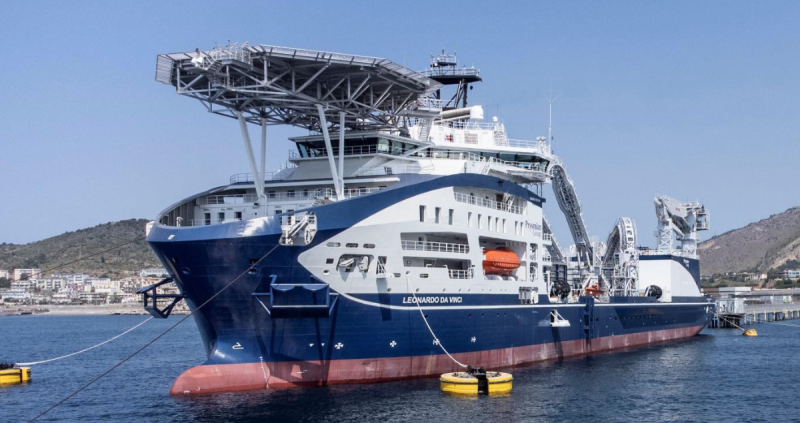The Italian-owned power-cable-laying vessel Leonardo da Vinci has begun a 4-month operation in the Persian Gulf to advance the $3.8 billion effort by the UAE’s Abu Dhabi National Oil Company (ADNOC) and Abu Dhabi National Energy Company (TAQA) to power and decarbonize ADNOC’s production activities offshore.
ADNOC expects to shrink its offshore carbon footprint by up to 50% once it replaces existing offshore gas turbine generators with sustainable power sources available on the Abu Dhabi onshore power network. TRANSCO, the Abu Dhabi Transmission and Dispatch Co. (a TAQA subsidiary), operates that network.
In January 2022, ADNOC became the first oil and gas major to source all its onshore grid power from solar and nuclear energy through a partnership with Emirates Water and Electricity Co.
Greening ADNOC’s Offshore Production: A First for MENA
Scheduled to begin commercial operations in 2025, the offshore decarbonization project will be the first-of-its-kind high-voltage, direct current (HVDC) subsea transmission system in the MENA region (Middle East and North Africa), according to ADNOC and TAQA.
Overall, about 1000 km of HVDC cables bundled with fiber optics, and the transmission system, will be laid with a total installed capacity of 3.2 GW. In addition, two independent subsea HVDC links and converter stations will be connected to TAQA’s onshore grid.
ADNOC said the vessel, owned by Italy’s Prysmian Group based in Milan, Italy, will work in UAE waters for an initial 4-month period after having arrived recently from Europe, according to a story in Arabian Business.
According to Prysmian, the Leonardo da Vinci can install power cable at up to 3000 m water depth. It boasts the highest carousel capacity on the market with two rotating platforms of 7,000 and 10,000 tons. The vessel’s 100-ton capstan capacity is twice the industry average, and its bollard pull of about 200 tons is the highest pulling-towing capacity in its class.
The vessel will operate between Mirfa on the western Abu Dhabi coastline and the offshore Zakum cluster, a distance equivalent to that between Abu Dhabi and Dubai. It will lay bundled cabling along the first 134-km route and return later to lay cables along a second 141 km-route, Arabian Business reported.
Island Hopping in the Persian Gulf
Clean grid power will be transmitted from two onshore locations, Shuweihat and Mifra, to Das Island and Zakum Island via two subsea cables which are both more than 130 km long. From these offshore islands, power will be distributed to other offshore installations, ADNOC said.
The offshore side of Abu Dhabi’s vision was first announced in December 2021 and is funded through a special-purpose vehicle—a dedicated company jointly owned by ADNOC and TAQA (30% stake each), and a consortium led by the Korea Electric Power Corp. (KEPCO) and including Japan’s Kyushu Electric Power Co. and French utility major EDF.
ADNOC and TAQA closed financing in September 2022 on the $3.8 billion deal that obligates the consortium to build, own, operate, and transfer the transmission system alongside ADNOC and TAQA, with the full project being returned to ADNOC after 35 years of operation.
KEPCO has worked in the UAE for over a decade, starting with an agreement in 2009 to build four units for the Barakah nuclear facility. In March 2023, the third of those four units contracted by Emirates Nuclear Energy Corp. for Barakah was put into commercial operation.


